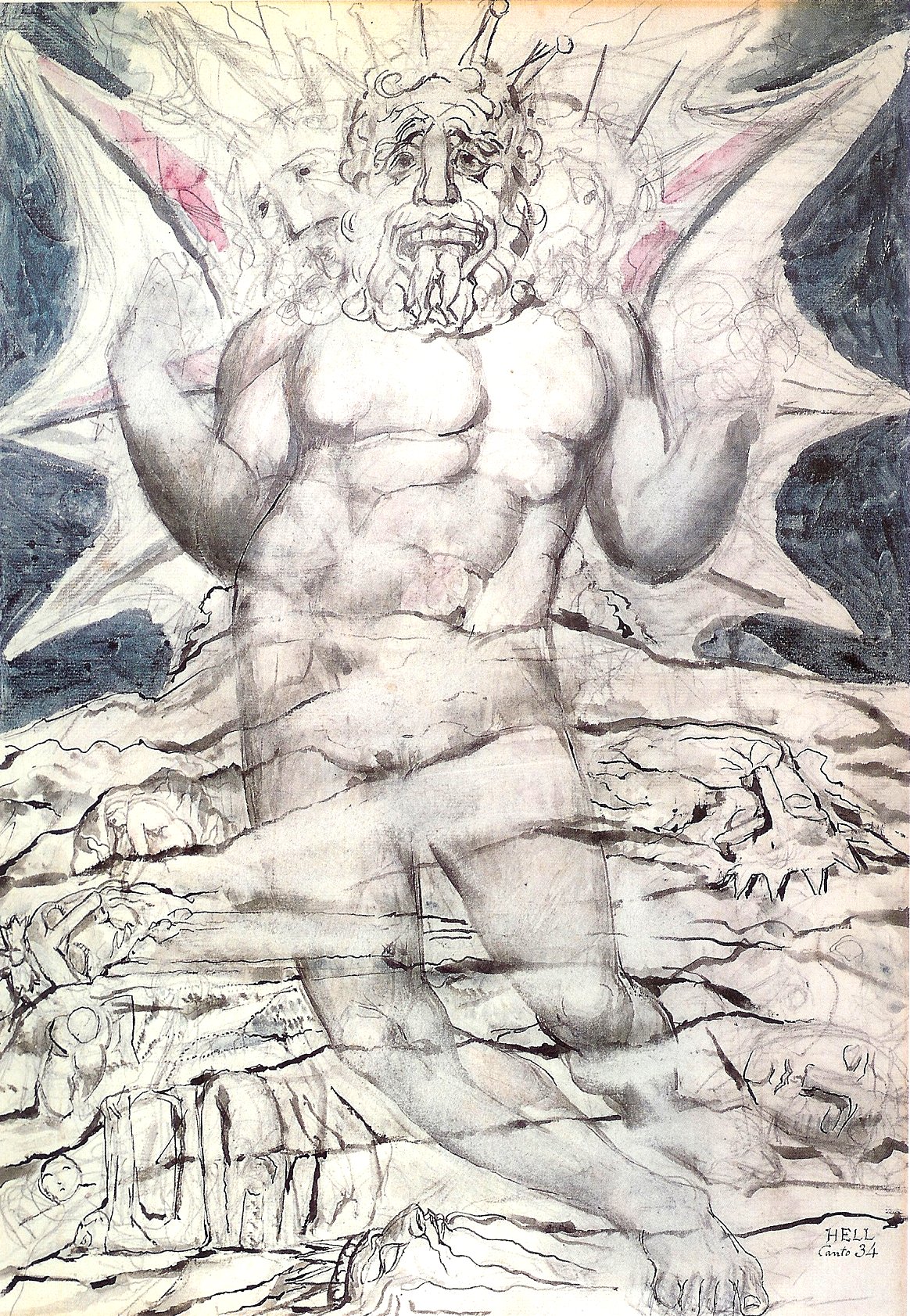Lucifer (Satan)
From Dante's Inferno XXXIV
The Emperor of the kingdom dolorous From his mid-breast forth issued from the ice; And better with a giant I compare Than do the giants with those arms of his; Consider now how great must be that whole, Which unto such a part conforms itself. Were he as fair once, as he now is foul, And lifted up his brow against his Maker, Well may proceed from him all tribulation. O, what a marvel it appeared to me, When I beheld three faces on his head! The one in front, and that vermilion was; Two were the others, that were joined with this Above the middle part of either shoulder, And they were joined together at the crest; And the right-hand one seemed 'twixt white and yellow; The left was such to look upon as those Who come from where the Nile falls valley-ward. Underneath each came forth two mighty wings, Such as befitting were so great a bird; Sails of the sea I never saw so large. No feathers had they, but as of a bat Their fashion was; and he was waving them, So that three winds proceeded forth therefrom. Thereby Cocytus wholly was congealed. With six eyes did he weep, and down three chins Trickled the tear-drops and the bloody drivel. At every mouth he with his teeth was crunching A sinner, in the manner of a brake, So that he three of them tormented thus. To him in front the biting was as naught Unto the clawing, for sometimes the spine Utterly stripped of all the skin remained. "That soul up there which has the greatest pain," The Master said, "is Judas Iscariot; With head inside, he plies his legs without. Of the two others, who head downward are, The one who hangs from the black jowl is Brutus; See how he writhes himself, and speaks no word. And the other, who so stalwart seems, is Cassius. But night is reascending, and 'tis time That we depart, for we have seen the whole." As seemed him good, I clasped him round the neck, And he the vantage seized of time and place, And when the wings were opened wide apart, He laid fast hold upon the shaggy sides; From fell to fell descended downward then Between the thick hair and the frozen crust. When we were come to where the thigh revolves Exactly on the thickness of the haunch, The Guide, with labour and with hard-drawn breath, Turned round his head where he had had his legs, And grappled to the hair, as one who mounts, So that to Hell I thought we were returning. "Keep fast thy hold, for by such stairs as these," The Master said, panting as one fatigued, "Must we perforce depart from so much evil." Then through the opening of a rock he issued, And down upon the margin seated me; Then tow'rds me he outstretched his wary step. I lifted up mine eyes and thought to see Lucifer in the same way I had left him; And I beheld him upward hold his legs. And if I then became disquieted, Let stolid people think who do not see What the point is beyond which I had passed. "Rise up," the Master said, "upon thy feet; The way is long, and difficult the road, And now the sun to middle-tierce returns." Thence we came forth to rebehold the stars.
The last Plate of Inferno.
 |
| Blake Hell 34 Lucifer |
When looking at the way Dante portrays [Satan] in comparison with early renaissance depictions, it can be seen how unique his idea was and how much of an effect it had during the time. As opposed to the popular conception of the era, which viewed Satan as an all dominating beast of Hell, found at its most fiery depths, Dante gives the portrayal of Satan as just another victim of Hell’s tortures. He places Satan trapped within the ice, stripped of voice and power and thus sets forth a new conception of who and what Satan is. With the understanding that during the time of the renaissance, many messages of the society were depicted through the [art]work (the artwork reflected the society and the society reflected the artwork) it can easily be seen how much of an effect Dante’s literary image of Satan had on the Society. The demonstration of this effect can be seen in the comparison of these three paintings done during the [Renaissance era]. The first one is the work of [Giotto di Bondone] (1267-1337), the [Last Judgment] found in the [Arena Chapel] in [Florence], the works of [William Blake] (1757-1827) and the works of Nardo di Cione (13501357)

As it can be seen, Giotto gives Satan a very dominant role in Hell and portrays him as extremely violent and gruesome. His depiction of Satan is representative of the popular conception before Dante and is in great contrast with the other two images of Satan. In Blake's work it can be seen that Satan is given three heads, each of which are consuming a body, just as Dante expressed in the Inferno. This is also true in Cione's work, though slightly less clear. The other characteristics that these two artists draw from Dante's Satan, is the lower body of the devil, which is strictly confined in ice. Satan is perceived with less power, as opposed to Giotto’s Last Judgment. Also found in Cione's work, which is represented in the Cappella Strozzi of the [Santa Maria Novella] in Florence, is the clear depiction of Dante's nine circles of Hell. Through this art work and others of the Renaissance, one can see how much of an influence Dante had in the understanding of Satan and [Christian theology].
No comments:
Post a Comment